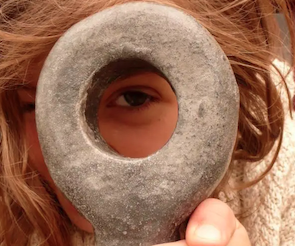In Roeg’s 1971 film ‘Walkabout’ sound and music plays a big part in creating the atmosphere that is integral for the film’s story, enhancing the contrasting relationship between humans and nature. The scene I have chosen below to analyse is when the girl and boy first come across the aboriginal boy on his walkabout.
SCENE FROM 34:19 – 37:46.
In this scene, both we as an audience and the boy and girl in the scene are meeting the aboriginal in silence, the only sounds available, both diegetic, are the noises coming from him as he catches the lizard and from the wind around them. As we are introduced to this boy, it is clear straight away that the sounds he makes are much more in tune to the surrounding nature, they’re man made sounds yes, but are all noises that can be easily replicated by nature and so are brains easily relate the two together. And in fact, it is vital for him that his sounds do blend into the nature so we instantly become aware that he is part of the desert.
The silence in this scene is in fact one of the most noticeable aspects, this new boy being introduced is of such an unknown to the other two that they can’t help but sit there and watch in silence. The lack of speech forces us as the audience to focus on the sounds that are present, and where they’re coming from. The closer the boy gets to the two, the sound of the wind continues, and in some parts even becomes more intense, this empathetic sound helps create this feeling of uncertainty and unknown. The reason the sound of the wind emphases these feelings is due to the perception we have as humans for wind. Wind usually suggests worse weather is coming and so it makes us feel we need to hide away and protect ourselves. Thus creating this ominous feeling that both the audience and the boy and girl are feeling.
Once speech becomes involved there is this build up of tension due to the lack of understanding on both sides, the language barrier creates this intensity that we haven’t yet seen since the kids have been alone in the outback. Once an understanding is made between them, we then see the boy helping the other two, which completely changes the atmosphere of the scene. Music then becomes involved. The music, a non diegetic sound, feels hopeful and adds this immediate sense of safety and acceptance to the film. It’s as if now these kids have come across the boy, they are going to be safe and guided through their unknown journey. As they begin to move on, the music becomes almost choir like and because of this, this sense of a powerful ‘god-like’ presence is introduced, someone to look out for them. The camera pans back looking down on the 3 as they wander off, as if to say they can go off by themselves now, and the music just adds this entirely new atmosphere to the film. Those prior feelings of uncertainty are removed completely. This is done simply all through the sounds we hear.
For a film that doesn’t involve an awful amount of speech, sound is incredibly important for telling the story, both the diegetic and non deistic sounds create an atmosphere that without, we as an audience wouldn’t be able to understand the film. The use of sounds, both in an empathic and anempathetic way, directs the emotion of each scene, giving us clues to what to expect with each new aspect we come across, and how the scene is going to pan out. This scene is a pivotal moment in terms of the narrative, and offers a rich soundscape to explore, setting the tone and exploring the contrasting relationship of lives between the two kids and the aboriginal boy. Although from completely different lives, they find themselves in the same situation and realise quickly to stay together. The drastic change in atmosphere made through the sounds represents this fast understanding of the fact they should stay together. What was first an unknown quickly became reliable.
